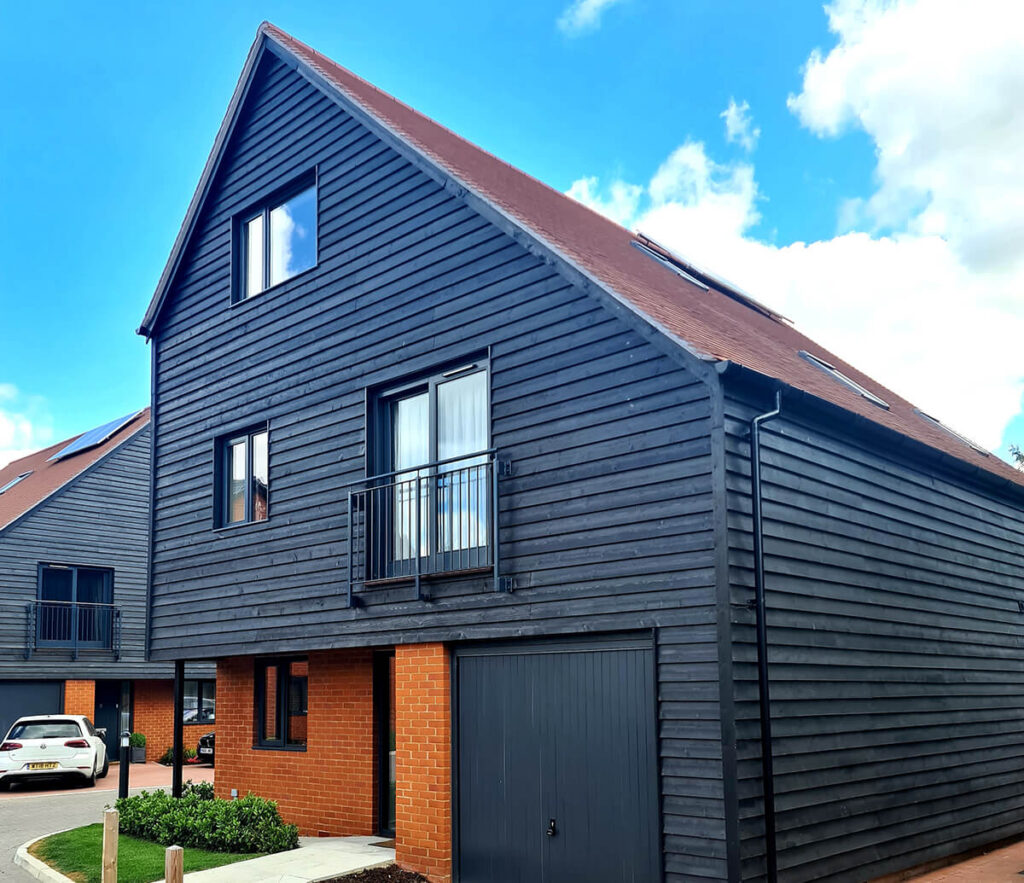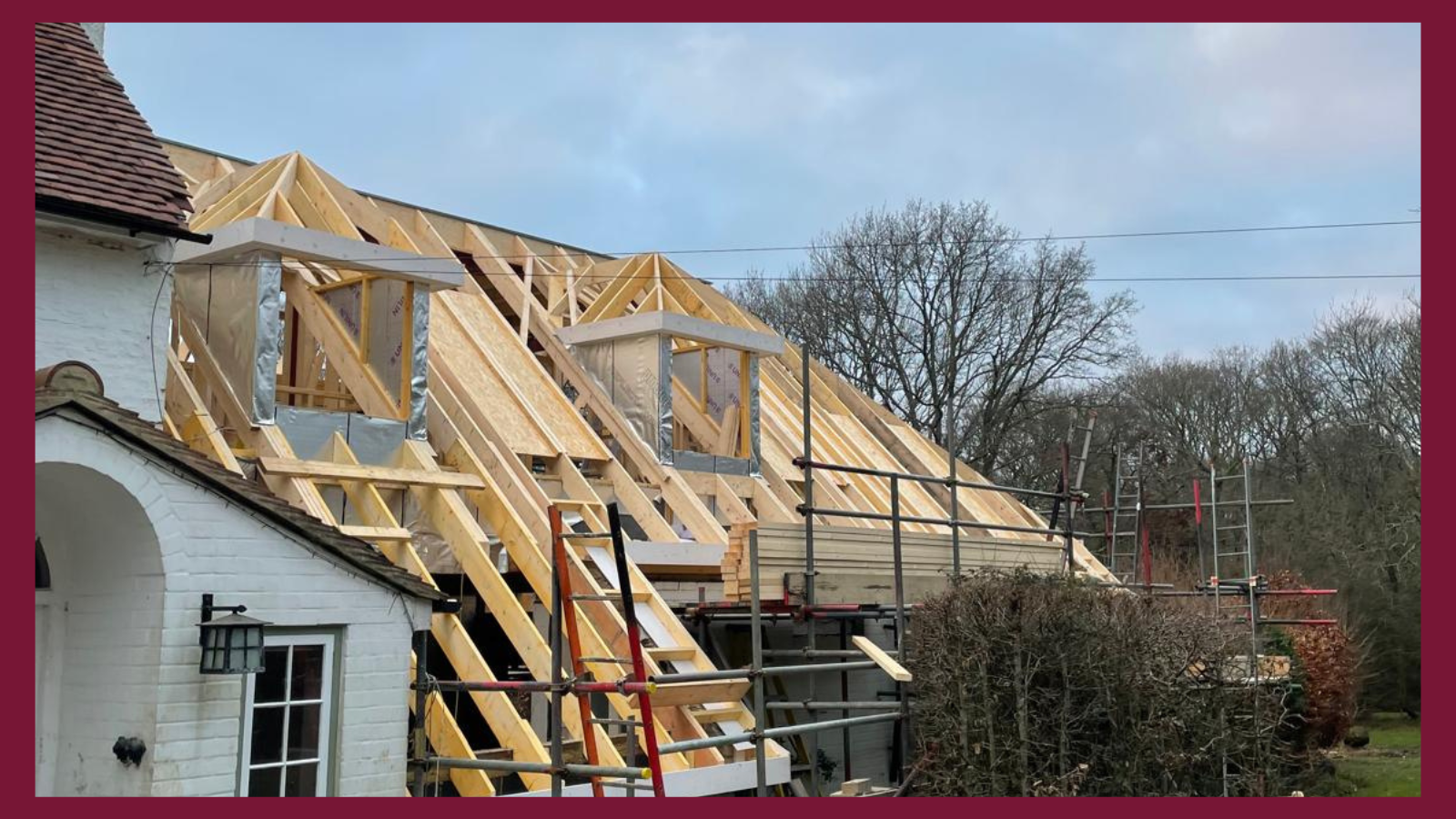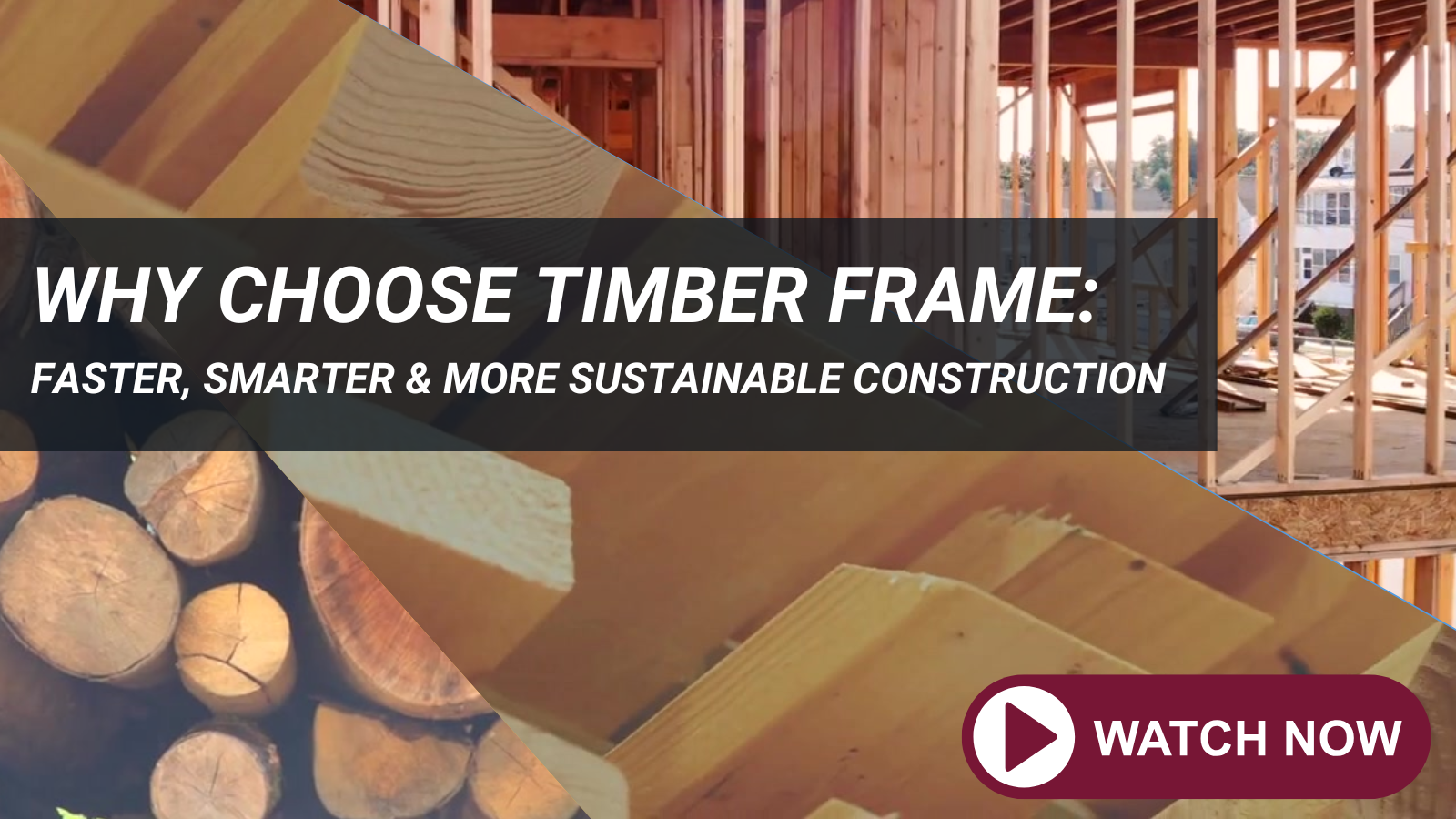DELIVERING TIMBER ENGINEERING EXCELLENCE
FAQs
Timber Frame Frequently Asked Questions
Before you decide whether a timber frame is the best option for your project, you may have some queries. Below is a list of some of the most asked questions about timber frames, roof trusses and metal web joists.
If you have any further queries, please do not hesitate to contact us for personalised advice on 01252 844747.
Alternatively, you can email us at one of the following:
timberframe-sales@merronbrook.co.uk
easijoist-sales@merronbrook.co.uk
truss-sales@merronbrook.co.uk
Ask us anything
We often get asked the same questions regarding our product range. Below are some questions and answers, that are regularly asked at the early concept stage for projects brought to us for quoting.

General Questions
A unit describes a dwelling on a site. So 10 houses, could be identified as 10 units.
Timber Frames FAQs
- Timber frame construction offers a wide scope and flexibility of house design.
- Frame erection can be done at any time of the year and, apart from extreme conditions, it is not affected by weather.
- A timber frame house can be built in almost half the time of other construction methods.
- Frames are precision-engineered in a controlled factory environment and each part of the frame is carefully cut and assembled, to exacting standards and plans.
- Timber frame houses meet all fire standards required under the building regulations and are correctly constructed in accordance, with detailing prescribed by third party warranty providers NHBC.
From an Architects design, Merronbrook offers a full consultancy, design, manufacture, supply and installation service, encompassing a timber framed structure, intermediate floors, and roofs.
A timber frame house is treated, detailed and weather-protected in accordance with the very latest standards of building technology to deliver a structural core which should last as long as the economic life-cycle of the home’s fixtures fittings, and finishings.
Timber framed homes are priced competitively when compared to masonry construction. When speed of installation is taken into account, timber frame can often be cheaper overall. Please speak to us about your project and we will do our best to give you a guide price at the earliest possible stage.
Closed-sided carports can be constructed using timber frame panels, and trusses or joists forming the roof. Merronbrook recommends using a fire retardant sheathing board as a backing to any planned combustible cladding (such as timber shiplap).
You must make sure that an additional stud is used, so when plasterboarding, the corner has a solid vertical to always secure too.
This is a house or structure built utilizing timber frame panels or at the very least, timber as the loadbearing structural walls of the build.
A timber frame house is difficult to identify, once completed. Most people would be unable to tell the difference. Using a stud-finder or similar would identify that the inner skin walling is made from timber studs, but identifying in interior wall partition as stud-frame would not necessarily mean the whole structure is timber framed.
From an Architects design, Merronbrook offers a supply and installation service, encompassing Frames, intermediate floors, and roofs.
Closed panel systems are manufactured by specialist timber framers.
Benefits are better thermal performance values, more sustainability, faster installation, and quality assured both in the factory and on-site. Timber frames are inherently warm but have a low thermal mass which can lead to summertime overheating in some buildings. Speak to your architect, or our in-house design team, about incorporating thermal mass to counteract this.
A timber frame wall is built from a core of 140mm CLS studs at max. 600mm centres, cladded externally with 9mm OSB and a high performance breather membrane. We offer an option to install a 100mm Phenolic rigid foam insulant into the stud-gaps. To complete you would apply a vapor barrier and plasterboard internally, before plaster-skim or tape & joint. These can be finished externally with traditional cavity brickwork or an alternative cladding system.
Our facility is open for an organized tour. Please contact us to arrange a suitable date and time.
The timber grade for timber frame stud panels is CLS.
CLS has a preservative treatment for moisture and TR26 would be treated for the risk of long-horn beetles. Please see the downloaded document for LONG-Horn Beetles.
Phenolic insulation gives us a 0.18 U-Value from a 100mm thickness, built with a brick outer skin.
Our timber frame kit offers a complete consultation service, including design, supply, and installation.
On any private project, we would advise having a site project manager for coordination. You will also require a sub-contractor to take on the elements of the build outside our remit. This would be explained in a consultation meeting.
A ‘supply & erect’ domestic new build project would be exempt from VAT, but an extension, or commercial building, or anything provided ‘supply only’ would be subject to VAT (currently 20%).
Fires can happen on traditional build sites as well as timber frame sites. Most fires that occur on any site are caused by deliberate arson. With the amount of timber present in a typical timber frame project, the risk of fire spread to neighbouring properties is elevated, but this is carefully mitigated by following the STA 16-point plan which is test-proven to ensure safety beyond the requirements of the Health & Safety Executive.
Engineered wood products such as trussed rafters, floor joists, and timber frame panels are all manufactured in a Quality Controlled purpose-built facility operating to the highest STA and ISO Quality Assurance standards.
A typical 3-bed house from Merronbrook is likely to be 8-12 weeks from Order, with a week or two to quote. 2 weeks for Line and point loads, 2-4 weeks for design and approval, 2-4 weeks for manufacture, 1-2 weeks for installation.
A mortgage is not dependant on the materials used in construction of the dwelling you are purchasing, only it’s warranty standard.
A third party warranty can easily be achieved on a timber frame building due to the high Quality Control processes operated, and the high standard to which it is designed.
Architects are educated in many forms of construction and apply this to their designs
A project manager should organize the follow-on trades, such as electricians, plumbers, plasterers, and bricklayers.
Anything pre-designed and manufactured in a quality controlled environment is going to be as accurate as the data inputted.
Materials throughout the industry have seen huge price increases, timber is one that has stabilized. So as a good guide, timber frame with its speed and prelim savings, would be more cost-effective.
Adding additional insulation to the internal face can achieve much greater U-values. Other materials such as insulated vapour barriers and insulated plasterboard, can all increase performance levels.
Once constructed and fixed properly, timber frame is a very solid form of construction.
Open-plan-living is achieved with support beams, helping to create greater spans and the desired larger room spaces.
Within kitchen and bathrooms, it is sometimes advised to apply a ply sheathing to the interanl face, giving secure fixing points and any desired location.
We only advise of possible value engineering changes, whilst working from detailed Architects drawings.
Timber frames will last as long as a traditionally built house. There is no data to say how long a timber framed home will be viable for, but with maintenance and continued environmental protection, .
Timber has been proven to be up to 3 times faster than conventional methods of building on the same size project.
Timber frame is currently one of the most sustainable building materials available. All timber used in UK construction comes from managed forest sources and uses very low amounts of energy to produce. Once built, the structure will retain sequestered carbon from the atmosphere for generations. Concrete and steel, in comparison, sequester no carbon, and require enormous amounts of energy to be created, and will require more energy at the end of the life-cycle to be re-used or recycled.
MMC means Modern Methods of Construction. So anything that is deemed to be an off-site manufactured product.
Timber frame performance for energy is one of the highest in MMC. A typical timber frame kit can achieve 0.18 U’Value, against .024 in traditional building methods.
There are no limitation to the size of build used in timber frame. It will be down to how it is designed and supported.
Timber frame should have a settlement time allowing any shrinkage, this is between 3-6mm per floor, and our designers will assist you with planning-in detailing that will accept this.
Timber as a material is highly combustible but this risk is carefully dealt with by tried & tested processes and design detailing. We follow the STA 16-point Plan to provide mitigations that limit risk to neighbouring dwellings in the unlikely event of a fire during construction, and once fully finished, fire-stopped and dry-lined to the current Part B standards, a timber frame building is no more susceptible to fire than any other form of construction. In most modern buildings all floor joists, decks, internal partitions, and roof structures are made of timber too, so if it were a risk, the risk would exist throughout. Statements made about timber frame’s fire safety tend to be based on technically inaccurate assumptions and prejudices.
Roof Trusses FAQs
- Roof Trusses widely replaced traditional cut roofs, not only for speed, but for their increased spans for larger buildings.
- Roof trusses can be designed and engineered to suit all kinds of roof shape configuration.
- An engineered truss roof can eliminate the need for potential steel beams required for support.
- Off-site construction means faster on-site erection.
- Carefully designed and engineered roofs can increase value and living space to a property.
Timber wall plates need to be fixed with minimum 100mm screws, in plugs (or hammer fixings) at minimum 600mm centres, then restrained with minimum 900mm wallplate straps at 1m centres.
Trusses, also known as trussed rafters, are engineered timber products used to create the structure and shape of the roof. These are then covered by felt and betten, before tiling.
A rafter is a sloped timber member used as either infill or as a structural member to form the slope in a roof.
In the simplest terms, this can be created using ceiling joists, roof rafters, hips, valleys etc., but by far the most effective method is to have an engineered solution designed by us. Speak to our Trussed Rafter department to get a truss roof designed with confidence.
An attic is a room that is formed within the roof space.
If delivered to the site and the dwelling is not quite ready. Trusses should be either laid flat and supports at the heels, apex, and at regular points to ensure twisting does not occur. Or slightly slanted in a rack. Keeping them banded together until required. In all cases, no timber products should be stored directly on the ground without bearers.
Restraint straps are fixed over the block work and over the trusses or rafters at 1500mm centers. Fixed using screws and plugs at blockwork and screws into the top of the rafter.
Truss clips are screwed at both sides of the truss to the wallplate and then to the truss itself.
Joists are built into the block wall, then block built up and around, then sealed to prevent air gaps.
A cut roof is a roof not using engineered products such as trussed rafters or flat roof joists.
Cost is dependant on truss type, span, size of timber etc.
A gable truss is a normal truss made into a panel to eliminate the need to create a blockwork internal gable skin.
Use the Wolf Systems manufacturer search to find a reliable supplier of Trussed Rafters near you: https://www.wolfsystem.co.uk/find-a-manufacturer/
You would need to expose the existing rafters, by taking off the tiles, felt and batten. Then link the roof, before replacing these finishes. If in any doubt you should get help from a qualified structural engineer.
This is not a recognised term. Floor joists are horizontal elements used to form a flat floor in a building. Trusses are engineered roof components used to form a roof’s shape and structure. Some roof trusses – called attic trusses – can also form a floor too.
Trusses are formed using ONLY structurally graded “TR26” softwood.
Truss bracing is horizontal at each node point, then diagonally braced with overlapping of 600mm
Hipped trusses are manufactured in a specialist factory.
Designing a roof truss is carried out by a specially trained designer, using knowledge of the required span, loading and roof shape.
A mono truss is used to form a single sloped roof, or to help form a hip end rood scape.
You will require cheek stud work, and ply cladding, then to form the flat area, joists laid to a fall, covered with ply.
Roof beams can go by many names and be of various materials. Ridge beam, purlin, or support beam,
Floor Joists FAQs
- Easi-joist® open metal web system allows easy installation of services such as pipes, cabling, trunking and ducts in the floor zone. The sturdy construction of metal web floor joists allows for a much longer span, in comparison to other types of joist.
- Their lightweight, yet robust design helps move the joist without it bending or twisting.
- The precision-manufactured easi-joists® reduce the installation time, in comparison to traditional techniques,
- Easi-joist® systems allow for the installation of a rigid Strongback that reduces vibration and improves the overall deflection performance of the floor.
Depending on the supporting span and room width within the roof space, the bottom chord of a roof truss would be designed accordingly, but we would suggest the timber section being 197-222mm x 47mm. For loft conversions, we suggest speaking to one of our Easi-Joist Designers who can specify you an engineered loft floor which is fully compliant with Building Regulations.
Joist centers and quantities would be dependent on span and loads. This calculation will determine the end quantity. Please see our joist calculator page.
The joist span, center, and loads will determine the joist width and depth of our engineered Easi-Joist floor system. Please see the Floor Joist span chart for details.
The joist span, center, and loads will determine the joist width and depth and centres of our engineered Easi-Joist floor system. Please see the Roof Joist span chart for details.
To reduce the incidence of squeaks, noggins should be connected using a proprietary connector. In our engineered Easi-Joist system, noggins are only required to support parallel upper-floor walls.
Floor joists are usually 400mm or 600mm centres apart, dependant on span and loads applied.
Floor joists are usually 400mm or 600mm centres apart, dependant on span and loads applied.
The cost of a joist itself, depending on length relatively small. The true cost would need to include the labour involved and what else needs replacing to safely complete the project, such as ceiling, decking and services. Specialist advice must be sought if wishing to go ahead with this.
Please see our joist span calculator.
A floor joist can be installed either being built into the internal block skin of the dwelling in hangers, fixed into the wall, or on a wallplate secured with hangers.
Joists would be manufactured and cut to trim against a ridge beam, secured with framing anchors or in hangers, then secured at the wallplate by being notched over and secured using framing anchors or hangers
Joists are the component in a structure that forms the floor or can be used as flat/sloped rafters.
You would need to take specialist advice.
Joists should be supported at each end and an intermediate support maybe required dependant on span.
Use the Wolf Systems manufacturer search to find a reliable supplier of Wolf easi-Joists near you: https://www.wolfsystem.co.uk/find-a-manufacturer/
Yes, given the correct loadings, a floor joist can be designed to take underfloor heating and a screed cover layer.
A posi-joist® is an open metal web engineered joist formed with metal plates on each side of a top and bottom solid timber member, using a system operated by MiTek®. Merronbrook use a similar system from Wolf call easi-joist®


